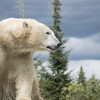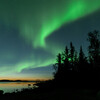Abandoned Mines & BIG Rock Discoveries

There’s the idiom “You’ve got rocks in your head,” meaning something about having poor judgment or a supposed substitute for brains. The loose definition of a rock hound is one who collects rocks. We like rocks, we pick them up.
So, why did more than 25 people, families for the most part, travel more than 700 km to find and collect rocks? They will tell you that “we’re insane,” and “we’re always looking for the next rock,” or “my wife says don’t bring any more rocks home.”

Dale Digman thinks so. He is a member of the Kitchener-Waterloo (KW) Gem and Mineral Club who made the trip to the Gowganda/ Matachewan area of Northeastern Ontario. “Yes, the seven-hour driving time trip from Ingersoll to Gowganda was definitely worth it. The drive was long, but I had the unique opportunity to meet some very interesting and knowledgeable people, see more of this fantastic province, and appreciate the greater opportunities that are available to each of us.”
And the reasons for his passion are as varied as the rocks: “I collect rocks and go on mineral collecting trips because I enjoy knowing more about geology and want to learn as much as I can from people who have a common interest as I do.”

“I will display the best looking and most interesting samples of the minerals that I have collected. I do have some rock equipment and plan to use those in my retirement to enhance the appearance of the collected samples,” he said. “I also enjoy giving things away and plan to give many of my findings primarily to younger collectors who are just getting started in the hobby.” Another member, Aimee Partlow, a teacher, has made a functioning “in tune” xylophone out of found drill cores found at many abandoned mine sites.
Rock Hound Profile
The southern Ontario club was created in 1965. For 50 years, the club has brought together people who have an interest in the lapidary arts and in collecting rocks, minerals, and fossils. Field trips are one of their popular programs. The club is also affiliated with the Central Canadian Federation of Mineralogical Societies (CCFMS), which includes similar clubs.
And then we come to Robert Land. He is definitely a “rock hound,” or aficionado, collecting since his eighth birthday. His vocation may be as interesting as his avocation and the rocks he intimately knows, as in “really knows.” More than a shoemaker, he reproduces shoes from the 16th to the 19th century for heritage re-enactments. But he is all about the rocks.

“This is one of many ‘passions’ rolled into one. The love of outdoors, metal detecting, and history. These old mines, even though most have been flattened by today, just exude history. The stories of the prospectors in canoes checking every outcrop,” Land said. “The old prospecting trenches in the bush, the forming of companies to exploit this mineral wealth, and in some cases to exploit people from their money. I also have a nice collection of early Ontario mining stocks. All Cobalt related. Having worked in numismatics (Look that one up! It is the study or collection of coins, paper currency, and medals), it is quite interesting to see where most of the silver in Canadian coins came from, and have a collection of these from different locales. Some mines – I have the specimen, the stock certificate, a photo from when the mine was in production, and what remains today.”

Land also says, “I keep a small selection of current specimens in my collection and the rest are in storage. I rotate the display. I have used some of my spare pieces for trading with other collectors and dealers to help acquire some rare specimens. The KW Gem and Mineral Club just celebrated its 50th anniversary this year. With a membership that is close to the hundred mark, it is one of the largest mineral clubs in Ontario. We actively promote the hobby to children, having the club’s own ‘pebble pups’ club.”
How about a rock story then? “Arriving at an old mine after being cooped up in the truck for seven hours, I immediately grabbed my tools and headed for the rock piles, forgetting to close up the tailgate of my truck. After half an hour or so, I got my fix and headed back to the truck for lunch. As I appeared behind the truck, I saw one of my loaves of bread run across the tailgate and jump off. It was attached to a racoon. The loaf of bread didn't upset me, I just stood and laughed. What really upset me was when I got to the truck, I saw he had ate two of my butter tarts. Another (critter) was collecting in the early spring and with my eyesight being focused on the ground right in front of my boots, I neglected to see this big pile of black and white fur in a bush just in front of me. Luckily, spring was in the air and these two skunks had something else on their mind besides ruining a rock collectors day. I beat a hasty retreat anyway.”
Rock On…

If you want to know where they were, find Gowganda on Hwy. 560, west of Elk Lake. Return east 2.2 km on the highway to the Everrett Lake Road. Turn North (left) from the highway. 2.2 km along, you will see your first adit. An adit is an entrance to an underground mine which is horizontal, or nearly horizontal, by which the mine can be entered, drained of water, ventilated, and minerals extracted at an easy level of access. Drive to the 3.2 mark and you will come to the Castle Mine. There is a myriad of roads to explore core racks (rocks)? and tailings piles. A really neat, horizontal open shaft (Lower Bonsall adit) to look at is located at WGS 84 17 T E 518793 N 5279823 or N47°40'17.49" W80°44'58.75".
Near Matachewan, the former Glendinning Mine property, which yielded Ontario barium and yarrow barite, was discovered in 1917 and active during the 1930's, is another point of interest. From Hwy. 65, northwest of Elk Lake, join Hwy. 566 and turn west through Matachewan. Take the southwest Asbestos Mine Road for 10 km to the bridge, which crosses the narrows of Mistinkon Lake. Park just beyond the bridge. You will easily see the abandoned road on the south side (left). It is a short walk to the tailings piles and open drifts. Take your buckets. Find N47° 53' 49'' W80° 46' 5'' or 17 T E 517472 N 5304774.
If you're a kid, or a kid at heart, and love rocks you'll enjoy www.rockhoundkids.com. If you are into Sunday drives and just want to look at the rocks, check out GeoTours Northern Ontario. It’s enough to keep you busy for a while. There are seven in the Sudbury area alone (in .pdf format for printing).
There are also the sayings: “between a rock and a hard place,” “steady as a rock,” and “Good. Let's rock and roll!” We all like to pick up rocks.
Tourists are always looking for the next BIG find. The last word goes to the rock hounds and they’re not crazy. “It is not worth knowing the rock unless you know where it came from! It's a great feeling when you can say that yes, I found it.”
Recommended Articles
The Seven's Best Hikes, Biking Trails and Lakes

7 Best Spots to Check Out in The Seven

Budget Bliss: Explore Northeastern Ontario Without Breaking the Bank

Bring Your Fam!

Time to Unwind: 6 Spa Havens to Discover In The Seven
5 Amazing Places to SUP in Northeastern Ontario

5 Amazing Bike Rides to Discover

Northern Lights in Northeastern Ontario

Northeastern Ontario's Best Pride Festivals

Fish for one of the World's Rarest Species of Trout

An Insider's Guide to Manitoulin Island

6 Small-Town Gems to Explore in Northeastern Ontario

11 Best Things to Do in Kapuskasing, Ontario





























